
No matter what, training a dog isn’t exactly easy. It’s usually the case when you start out that the dog has no idea what you’re trying to get them to do and the process is frustrating for both of you. Once you establish a method of communicating, things begin to improve little by little until you’ve got a repertoire of commands that you can use to motivate the dog to action.
Choosing that method of communication is fairly subjective, and it usually revolves around the collar. A training collar serves a very specific, and hopefully short-lived, purpose. Typically, the point is to use them to issue corrections when your dog either misbehaves or ignores a command. This is the basis of aversion training at its most fundamental — teaching your dog to avoid corrections by completing an action.
To help you guide your dog toward proper behavior, here are our picks for the best dog training collar.

|
Amazon Customer Reviews
|
Price: $349.99 Shop at Amazon | Shop now Read our review |
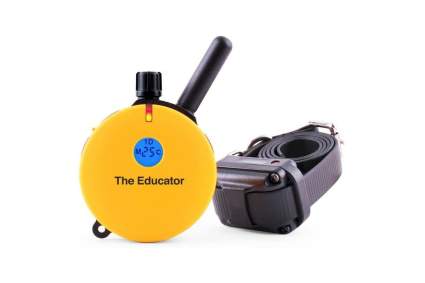
|
Amazon Customer Reviews
|
Price: $219.99 Shop at Amazon | Shop now Read our review |
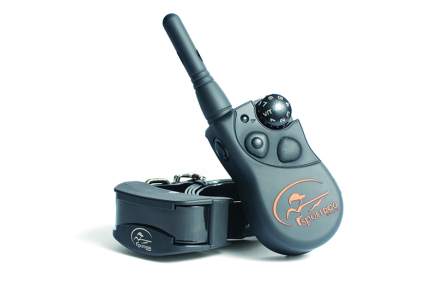
|
Amazon Customer Reviews
|
Price: $169.99 Shop at Amazon | Shop now Read our review |
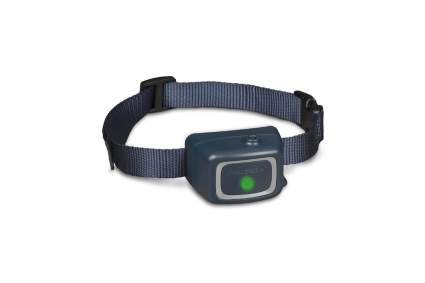
|
Amazon Customer Reviews
|
Price: $74.95 Shop at Amazon | Shop now Read our review |

|
Amazon Customer Reviews
|
Price: $34.99 Shop at Amazon | Shop now Read our review |

|
Amazon Customer Reviews
|
Price: $13.79 Shop at Amazon | Shop now Read our review |
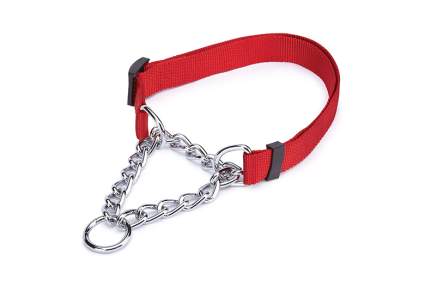
|
Amazon Customer Reviews
|
Price: $6.40 Shop at Amazon | Shop now Read our review |
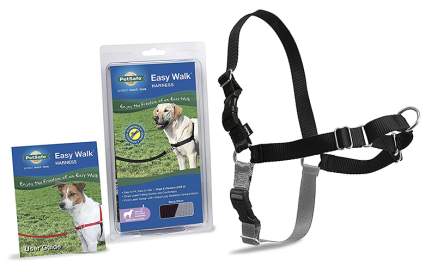
|
Amazon Customer Reviews
|
Price: $22.95 Shop at Amazon | Shop now Read our review |
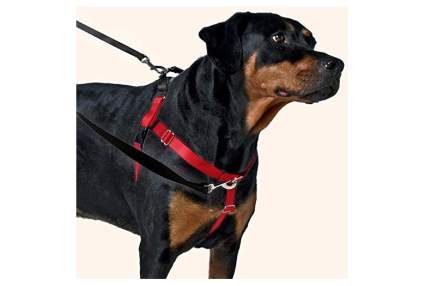
|
Amazon Customer Reviews
|
Price: $41.90 Shop at Amazon | Shop now Read our review |
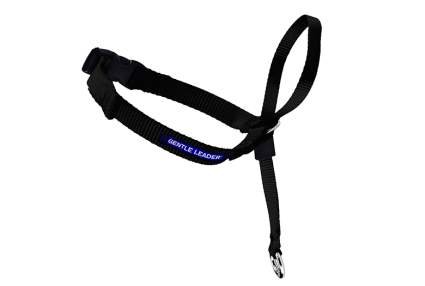
|
Amazon Customer Reviews
|
Price: $19.95 Shop at Amazon | Shop now Read our review |
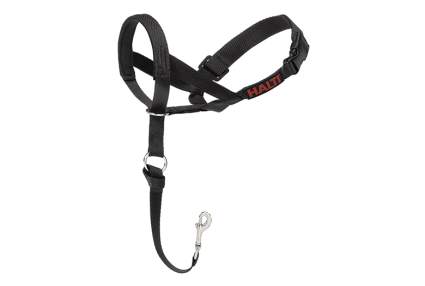
|
Amazon Customer Reviews
|
Price: $15.51 Shop at Amazon | Shop now Read our review |
-
1. Garmin Delta XC Bundle Dog Training Device
Pros:- Easy to read LCD screen
- Dedicated buttons for each stimulation form in changeable configurations
- 18 stimulation levels
- 1/2 mile range
Cons:- Expensive
- Despite device water rating of IPX71, contacts can still corrode
- Even the included long contacts may not
- No lock to prevent accidental corrections
This Garmin unit offers a combination of features and quality usually not found in these types of devices. I’ve seen this particular unit in action and can attest to the high-end feel of the remote and preciseness of the controls. There are 18 levels of stimulation available in this device, which is probably enough for most people to find the right level for their dog.
The pre-programmed training modes map the three buttons on the front to different functions depending on the mode. TVM makes the top button Tone, the middle Vibration, and the bottom Momentary static shock. VCM is Vibration, Continuous shock high, and Continuous shock low, and TCM is Tone, Continuous shock high and Momentary shock low, respectively.
If you upgrade to the Delta Sport XC or the Delta Upland XC, two additional modes are avaialable, as well as a Barklimiter and in the case of the Upland, a location Beeper. The range on the Delta is 1/2 a mile and 3/4 of a mile on the upgraded units.
Each remote can have up to three dog devices attached to it, and a dedicated button makes switching between them easy. The stimulation level is controlled with dedicated buttons on one side, and the mode with a button on the other. It’s a very nice unit and the dog I observed very quickly learned to respond to the tone.
Find more Garmin Delta XC Bundle Dog Training Device information and reviews here.
-
2. Educator E-Collar Remote Dog Training Collar
Pros:- 100 stimulation levels
- Your choice of ranges
- Strong signal even out of line of sight
- Easy controls
Cons:- Only works for two hours on a charge
- Somewhat difficult to plug in
- Tapping mechanism doesn't deliver a true continuous mode
- Plastic collar could be better
This is one of the most popular electric stimulation collars on the market. The simple control set and great flexibility mean this is likely to work on a wide variety of dogs.
The control layout includes a simple knob on the top to set the stimulation level between one and 100. That might be a little fiddly for some, but for those who want the ability to scale slowly in small increments, it could be better than some other options. Sometimes, you’ll find that the step from one level to another is too much for your dog and this solves that issue.
The other buttons on the side map to the Tapping mode, which is this collar’s version of vibration mode. This is highly dog dependent, but for some, it could be more attention-getting than others. There are also two buttons for the static stimulation: One is the standard button which outputs at the level shown on the screen, and one is a “Boost” mode which can quickly add stimulation if needed. There are also buttons for a collar light and a momentary/continuous switch.
There are also multiple models to choose from. This is the standard model with a 3/4 mile range, and you can choose between one and two dog setups. There’s also the Mini Educator with a 1/2 mile range, Upland with a one mile range, and Micro Educator with a 1/3 mile range.
-
3. SportDOG Brand FieldTrainer 425
Pros:- 500 yard range
- Compact remote
- Easy selector wheel for seven levels of stimulation or Vibration/Tone
- Waterproof put to 25 feet
Cons:- No LCD readout
- Expensive
- 425 unit only for low to medium stimulation and may not work on especially stubborn dogs
- Small range of stimulation levels
This dead-simple electronic collar is really aimed at sport dogs with its extremely compact, DryTek waterproof remote. The thumb wheel allows you to assign the button on the front to either vibrate or one of seven levels of stimulation. The button on the side remains a tone button, which is great if your dog gets the idea quickly and doesn’t need further shocks.
With the Add-A-Dog collars you can train up to three dogs with one remote. The 425 is meant for low to medium stimulation and should work on most dogs. If you’ve got a very large or stubborn dog, they also make the FieldTrainer 425S that increases the shock level. On a single charge, you can get 50 to 70 hours of use, after which a recharge takes only two hours.
Find more SportDOG Brand FieldTrainer 425 information and reviews here.
-
4. PetSafe Spray Bark Dog Collar
Pros:- Gently corrects barking
- Lightweight
- Rechargable
Cons:- On the pricey side
- Cartridges run out quickly with active barkers
- May activate when your dog is doing something other than barking
If you’re having trouble with your dog barking too much at inappropriate times, this is the collar for you.
PetSafe furnished me with a sample of this collar, which is rechargable via the included USB cable, for use with my extremely loud blue nose pitbull. I was reluctant to use static correction collars because he has an extremely thin coat and it just felt like overkill. I didn’t expect much of this, which uses tiny cartridges of either citronella-scented liquid or unscented liquid to gently redirect his barking efforts.
However, I was more than impressed. It takes, at most, two sprays for him to quiet down. Over the course of a week, just wearing it meant he thought twice about barking, which in turn led to an overall calmer demeanor, which was a bit of a surprise for me. In general, I think of these types of collars as anxiety-inducing, but that just wasn’t the case with this. Give this a try with your incessant barker.
Be warned, however, to make the collar as compact as it is, especially compared to earlier attempts at this, the cartridges are quite small and run out relatively quickly. You can get refills here.
Find more PetSafe Spray Bark Dog Collar information and reviews here.
-
5. Herm Sprenger Ultra-Plus Prong Training Collar
Pros:- Solid fastener and center plates for improved safety
- High quality fit and finish
- Adjustable size by removing or adding links
- Blunt prongs won’t injure with proper use
Cons:- Prong collars aren’t for every dog owner
- Can be somewhat difficult to get off
- Each link piece can separate, requiring redundant collar in the event it falls off
- Measuring and choosing the right size can be tricky at first
If you’re going to use a prong collar, the Herm Sprenger reigns supreme. From the plates that connect the different segments to the design of the prong, this is the way to go. What you get is pretty evident from first glance, with two sections of prong links connected by a symmetrical center plate. The cinching chain is also connected by two solid plates, which isn’t always the case in cheaper versions. The prongs are long enough for dogs with thick coats and blunt enough to simulate another dog’s warning bite, which is the point of this approach.
If you really can’t get on board with the metal ends, there’s also the Pettom Gear Steel Prong Collar which has removable rubber tips. In general, it’s a little cheaper, a bit less well-reviewed, and doesn’t feature the solid connecting plates.
Find more Herm Sprenger Ultra-Plus Prong Training Collar information and reviews here.
-
6. StarMark Pro-Training Dog Collar
Pros:- Advertised as being more humane
- Easy to put on and take off
- Looks more like a traditional collar
- Gentler correction
Cons:- Thin fabric band makes up cinch mechanism
- Links can occasionally pop free with very hard pulling
- Not as effective as traditional prong collars
- May not work on dogs with thick coats
If you just can’t stand the look or concept of the Herm Sprenger, this StarMark collar updates the approach. Using watch band style links, the prongs are blunter and made of plastic. This reduces the force of the correction, which is good for those who are nervous about it. The trade off is that this collar isn’t quite as effective, especially for long-haired dogs.
It comes in two sizes — 15 inch and 21 inch — but reviews seem to indicate that these measurements aren’t especially useful. The real key is that the small collar is made up of 3.5 inch links, while the large collar is made up of 4.5 inch links. Fortunately, you can always take links out and they make expansion kits to ensure proper fit.
Find more StarMark Pro-Training Dog Collar information and reviews here.
-
7. Guardian Gear Martingale Adjustable Choke-Style Dog Collar
Pros:- Safe, reliable control of your dog
- Inexpensive
- Chain cinch mechanism offers superior strength
- Range of color options
Cons:- Collars run a bit large (but are adjustable)
- Addition of the chain makes collar heavy
- Must be slipped on — no opening mechanism
- Some complaints that the chain stains white fur
Here’s a very inexpensive option that combines the strength of chain with the comfort of a nylon collar. For less than $10, you can get a very effective choke-style collar without the need for prongs, or choking for that matter. This collar is meant to give gentle correction and prevent your dog from getting free when they struggle against the lead.
It’s available in three sizes: small (13-18 inches), medium (16-24 inches), and large (22-34 inches). Color options include red, purple, pink, light blue, blue, and black.
Find more Guardian Gear Martingale Adjustable Choke-Style Dog Collar information and reviews here.
-
8. PetSafe Easy Walk Harness
Pros:- Multiple adjustment points for a proper fit
- Attaches in the front and turns the dog toward you during correction
- Unlike Martingale collars, buckles provide easy-on, easy-off use
- Chest strap is well away from the throat to prevent injury
Cons:- Sizing chart may not be accurate
- No padding
- Strap could rub off a small patch of fur under the shoulder
- Some reviews complain of failed plastic buckles
As you’ll read in the anecdote I relate below, this is the harness I use for my docile and bright dog. He’s not a very strong puller, but he’s still 60 pounds of stocky animal who can generate power if he decides to put his mind to it. With the attachment in the front, a strong tug or correction from me reminds him to turn and look at me and breaks his attention from whatever distraction he’s focused on.
In five years of use, it’s still just as reliable as the first day, though it should be noted that he isn’t a chewer whatsoever. The sizing chart is a little fiddly, to be honest, but they offer you a number of options and the adjustment on each is generous enough. The bottom strap is always another color so you can easily distinguish the top from the bottom in these color combinations: Royal Blue/Navy Blue, Red/Black, Raspberry/Grey, Fawn/Brown, Deep Purple/Black, Black/Silver, and Apple Green/Grey.
Below is the sizing chart. For reference, my dog uses a size Large.
- Petite: Chest – 6 inches to 7 inches; Girth – 12 inches to 16 inches
- Petite/Small: Chest – 8 inches to 9 inches; Girth – 13 inches to 18 inches
- Small: Chest – 8.5 inches to 11 inches; Girth – 15 inches to 21 inches
- Small/Medium: Chest – 11 inches to 13 inches; Girth – 19 inches to 26 inches
- Medium: Chest – 12 inches to 15 inches; Girth – 21 inches to 32 inches
- Medium/Large: Chest – 14 inches to 18 inches; Girth – 24.5 inches to 34 inches
- Large: Chest – 16 inches to 21 inches; Girth – 27 inches to 40 inches
- Extra Large: Chest – 17.5 inches to 23.5 inches; Girth – 32 inches to 50 inches
Find more PetSafe Easy Walk Harness information and reviews here.
-
9. Freedom No-Pull Dog Harness Training Package with Leash
Pros:- Two-leash system allows for greater control
- Comes with leashes and harness
- When training is complete, you can use whichever connection point works best for your dog
- Variety of sizes and colors
Cons:- Having to contend with two leashes complicates work for the owner
- Strap could rub off a small patch of fur under the shoulder
- Some fraying issues
- Questionable customer service
The novel approach here is the inclusion of two attachment points in the same harness. Typically, you get either a connection in the front or on the back. Additionally, this kit includes the two leashes you’ll need to steer your dog, similar to reins on a horse. If your dog is an especially bad puller, you’ll have complete control to redirect their lunging.
It’s certainly more work for you, but being that this is a training harness, work is exactly what you’re doing during this period. There are four adjustment points to make sure the harness fits snugly. Colors include Black, Royal Blue, Rose Pink, Red, Orange, Teal, Chocolate, Purple, Burgundy, Raspberry, Green, and Tan.
The sizing options on Amazon are a bit confusing, but the following guidelines are outlined:
- X-Small: Chest – 14 inches to 20 inches; Neck – 10 inches to 14 inches (Approx. weight 12 to 17 pounds)
- Small: Chest – 18 inches to 24 inches; Neck – 10 inches to 14 inches (Approx weight 18 to 25 pounds
- Medium (5/8 inches width): Chest – 23 inches to 28 inches; Neck – 14 inches to 18 inches (Approx. weight 25 to 40 pounds)
- Medium (1 inch width): Chest – 23 inches to 28 inches; Neck – 14 inches to 18 inches (Approx. weight 40 to 65 pounds)
- Large: Chest – 27 inches to 32 inches; Neck – 16 inches to 20 inches (Approx. weight 60 to 85 pounds)
- X-Large: Chest – 31 inches to 37 inches; Neck – 20 inches to 26 inches (Approx. weight 85 to 140 pounds)
- 2X-Large: Chest – 36 inches to 44 inches; Neck – 26 inches to 34 inches (Approx. weight 140 to 250 pounds)
Find more Freedom No-Pull Dog Harness Training Package with Leash information and reviews here.
-
10. PetSafe Gentle Leader Head Collar
Pros:- Very effective for limiting pulling
- Padded nose loop
- Precise head control
- Good training model
Cons:- Not a traditional harness
- Other people may mistake this for a muzzle and think your dog is hostile
- Requires a training period
- Snout clip may break
We included the Gentle Leader at the end of our best dog harnesses post in part thanks to its ubiquity. They’re easy to find and have a proven track record. Like the Easy Walk, this is one I use for one of my dogs — a husky mix who lunges and pulls frequently.
Unlike the method you’d use with prong collars, the correction with a head collar is gentle redirection rather than a sharp snap. They take some getting used to, both for you and the dog. Still, there are claims that once your pup adjusts this collar can actually have a calming effect on them, which reinforces your anti-aggression training.
Sizes include Petite (five pounds or less), Small (six to 25 pounds), Medium (25 to 60 pounds), Large (60 to 130 pounds), and Extra Large (over 130 pounds). Colors include Black, Raspberry Pink, Red, Silver, Apple Green, Deep Purple, Fawn, and Royal Blue. The package also includes a training DVD to get you started.
Find more PetSafe Gentle Leader Head Collar information and reviews here.
-
11. Halti Head Collar
Pros:- Safety loop attaches to regular collar for extra safety
- Single connection point for leash
- Padded nose band
- Especially effective for larger dogs
Cons:- Some complaints of relatively short material lifespan
- Hard pulling can lead to neck strain
- May have to try a few sizes to find the right one for your dog
- Requires a training period
Though the Halti works on the same premise as the Gentle Leader — one loop behind the jaw and one over the nose — this one differs in two ways. Rather than having two straps that need to be connected to the leash, the Halti has only one connection point. That same ring has a safety strap on it which is meant to connect to your dog’s normal collar, thereby improving the overall security should the Halti fall off for any reason.
You can augment the head collar with the use of the Halti Training Lead and Halti Training Harness, which turns this into a solution very similar to the Freedom harness above, with the added benefit of being able to control the head directly.
Colors appear to only be black or red and sizing is as follows, measured by the neck:
- Size 0: 11.8 inches to 15 inches
- Size 1: 12.6 inches to 16.1 inches
- Size 2: 14.2 inches to 18.5 inches
- Size 3: 15.7 inches to 20.9 inches
- Size 4: 17.7 inches to 24.4 inches
- Size 5: 20.5 inches to 28.9 inches
One way to think about it is that each journey outside the house is a life-or-death proposition for your dog, even more than for you. Sure, you could get in an accident at any time, but it's far less likely that a single mistake on your part will result in your death. The same cannot be said for dogs.
Thanks to a combination of poor dog ownership and overzealous laws, if your dog ends up in a situation where they feel threatened and bite another person or another dog, the risk that you will be forced to put them down is high.
This goes double for hunting or working dogs, for whom a lack of training can easily lead to a fatal slip-up. So, while you may not be comfortable with the idea of a prong or electric collar, keep in mind that the quicker you can train them with the fewest number of corrections, the safer your dog will be out in the world.
That being said, the solutions we've chosen below cover a range of options, from the tried-and-true (but frowned upon by some) prong to the harmless harness. You have to make the right choice for your situation, evaluating the pros and cons of each against the difficulty of your particular animal.
As you consider what approach you want to take with the collar, you may want to peruse our list of the best dog training books to help decide what approach you'll take with training in general. The book you decide to follow will certainly have a recommendation as to which collar is best suited to that style of training.
Ultimately, you have to go with what feels most comfortable to you to be sure that you stick with it. There's a lot of disagreement out there.
Two other points to consider. First, it's a good idea to combine corrections with positive reinforcement. Work with your dog, encouraging them when they complete a desired action. Treats won't always work when your dog is otherwise distracted, so a blended method is most likely to be successful.
Second, since this balanced interaction is integral to forming a bond with your dog as you train, we haven't included anti-bark collars on this list. If you're going to use a static shock collar, be present with them to issue a command and keep your dog learning.
It may actually hinder your efforts for your dog to receive a correction with no easy way to correlate it to a specific action. As always, consult a veterinarian or a qualified dog trainer if you're not comfortable making these decisions.
Dog Training Collar Styles
Prong Training Collars
Perhaps the most basic of training collars, the prong collar works by providing a sharp but non-damaging pinch when you tug the leash. They're certainly not without controversy, but there's a school of thought that these offer the most direct form of correction. It's also easily controlled, so your actions can be clear and crisp.
These allow you to have a consistent conversation with your dog, curbing pulling and leash aggression while teaching focus. You don't want your dog on one of these all the time as there is a danger of injury, but in short, focused training sessions, they can be very effective.
Martingale Training Collars
The purpose of the Martingale design is that it prevents dogs from slipping backwards out of the collar. Like a prong or a choke chain, it has a cinch mechanism made of either chain or fabric that tightens the collar when pulled. There are no prongs and the choking hazard is greatly reduced as the smallest a Martingale can get is the size of your dog's neck.
All-fabric Martingale collars also eliminate the sound of the snapping chain, although this audio cue can be useful at times. They make good training collars in that they help control stubborn dogs while being somewhat easier to use.
Dog Training Harnesses
While a training collar should be capable of communicating corrections to the dog, the most important feature is that it securely protects the dog from escape. Since an untrained dog isn't yet ready to respond to commands, having them slip out of the collar is the worst possible scenario.
Harnesses expand the points of restraint to the dog's entire body, which helps to ensure that they won't get loose. We've included the Freedom No-Pull Harness that appeared on our best dog harnesses post as another option for you to consider.
Dog Head Collars
As the saying goes, "Control the head, control the body." In some ways, a head collar is a more extreme solution than the others on this list, because the control point moves to the top of the dog's nose. If your dog is particularly aggressive, a head collar will ensure control at the point at which they are most likely to make contact with another dog or a person — the mouth.
There are a few drawbacks, notably that dogs without a pronounced muzzle can't make the best use of them. They can also be mistaken for a muzzle, which causes other dog owners an increased level of anxiety that really isn't warranted. This can escalate a situation needlessly. Nevertheless, they are very effective and worth considering.
Electronic Dog Training Collars
Perhaps a last resort for some people, electronic dog collars are highly effective at issuing finite, specific correction. While most models do offer varying levels of static shock, they also offer tone and vibration modes.
Based on what I've seen, it takes only one or two shocks total for most dogs to associate the tone with the correction, so it really isn't necessary to utilize the shock function very much at all. The vibration is usually more than enough to prompt action and the extended range makes off-leash training much easier.
How Do I Choose a Dog Training Collar?
The most important evaluation you need to make is that of your specific dog. By way of example, I have three dogs: one is a 60-pound Shar Pei/pit bull mix, one a 60-pound blue nose pit, and the last a 70-pound husky/pit bull mix. The Shar Pei and the blue nose both have thin, loose coats.
The shar pei is extremely sensitive by nature. He isn't aggressive nor particularly energetic, and he picks up commands most of the time by the third try, thanks to his excellent focus. For him, I use the Easy Walk harness, which turns him to face me when I need his attention. This is more than enough to have a consistent dialogue when we're out.
The husky, on the other hand, is extremely energetic, profoundly unfocused, and has a penchant for leash reaction. He's not aggressive, but he doesn't appreciate thresholds at all. He also has a much thicker coat and a very, very strong pull.
For him, we use a prong collar during short training exercises, and a Gentle Leader during short walks, and the Freedom No-Pull harness for longer walks. He would absolutely get himself into trouble if not for this paradigm. He also has by far the highest pain threshold of any dog I've ever met, so his sensitivity is far lower than the other two.
The blue nose requires a mix of approaches that are more varied. Despite his thin coat, he tends to ignore stimulation inputs. He's an obsessive puller, owing to spending most of the first two years of his life in a shelter; the world is still very exciting to him.
We use all the collars we own for him depending on the situation and limit training to shorter excursions because he's more likely than the other two to get frustrated. Still, once he learns something, it appears to be stuck in his brain forever.
After only a few weeks, the behavior of the husky and the blue nose dramatically improved and very soon we'll discontinue the use of the prong collar altogether. If you notice that your dog is becoming more anxious and reactive, it's a good idea to switch to one of the other styles. It truly depends on the dog and the comfort level of the trainer.
See Also: